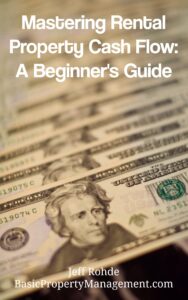Maximizing Rental Property Cash Flow: Strategies for Owners

Understanding cash flow is essential for building long-term wealth and stability as a rental property owner. Maximizing your rental property cash flow means strategically increasing your income while keeping expenses under control, so you can see real results in your bottom line. Whether you’re new to real estate or looking to refine your approach, focusing on efficient cash flow management will help you achieve consistent growth.
You have many options to improve cash flow, from adjusting rent prices and reducing operating expenses to adding new revenue streams like pet rent or paid parking spots. Balancing competitive rents with high occupancy is key to maximizing profits and tenant retention.
In this article, you’ll gain actionable insights into the difference between net and gross cash flow, practical steps to elevate income, and essential metrics to track for sustainable success. Get ready to optimize your property’s performance and boost your investment returns with straightforward strategies.
Key Takeaways
- Maximize returns by focusing on net cash flow and operational efficiency.
- Use proven techniques to increase revenue while maintaining tenant satisfaction.
- Monitor key metrics to ensure long-term property and portfolio growth.
Core Strategies for Maximizing Rental Property Cash Flow
To maximize rental property cash flow, you need to focus on increasing income, cutting expenses, and ensuring tenants remain satisfied and long-term. Each element impacts the bottom line and helps you achieve reliable returns on your investment.
Optimizing Rental Income
The most direct way to boost cash flow is through detailed rent evaluations and adjustments. Assess your property’s rental price at least annually to ensure it aligns with current market rates. Underpricing can hurt your returns, while overpricing can increase vacancies.
Offer additional revenue-generating options to enhance cash flow. Consider renting out garages or storage space separately, providing paid amenities like in-unit laundry or pet fees, or charging for parking—all of which are proven methods to increase property income as highlighted in this guide for rental property owners.
Aim to maintain high occupancy rates to avoid income gaps. Market your property with professional photos and clear descriptions to attract qualified tenants quickly. Automated online rent collection and flexible payment options can encourage prompt payments and minimize late fees.
Reducing Operational Costs
Careful expense management is critical for net cash flow improvement. Shop around for competitive insurance policies and consider bundled coverage options to get better rates. Regularly review service contracts, such as landscaping or repairs, and renegotiate or replace vendors if costs rise.
Adopt preventative maintenance to control repair expenses over time. Schedule routine inspections and address small issues early to avoid costly emergencies. Energy-efficient upgrades—like LED lighting, smart thermostats, and water-saving fixtures—reduce utility bills, often resulting in direct savings for you or indirect benefits if utilities are included in rent.
Track every expense using property management software or detailed spreadsheets. This helps you identify unnecessary or excessive costs and optimize your operating budget without sacrificing quality or tenant satisfaction.
Improving Tenant Retention
Reliable tenants are essential for steady cash flow, as higher turnover means vacancy losses and marketing expenses. Screen tenants thoroughly to select responsible individuals who are more likely to stay long-term and pay on time.
Good communication and swift responses to maintenance requests help build positive relationships. Responding to tenant concerns quickly can prevent disputes and leads to higher satisfaction. Well-maintained properties with modern amenities encourage tenants to renew leases.
Consider implementing annual appreciation events, minor upgrades at renewal, or a loyalty discount for long-term tenants. Retention-focused incentives are often more cost-effective than advertising and onboarding new tenants, ensuring ongoing stability and fewer disruptions to your cash flow. Read more practical ideas in comprehensive guides on maximizing rental cash flow.
Advanced Techniques for Enhancing Revenue
Improving your rental property’s cash flow requires more than just adjusting rent amounts. Strategic upgrades, tax optimizations, and new income channels can increase your net returns and reduce risk.
Leveraging Value-Add Upgrades
Adding or upgrading amenities can attract quality tenants and allow you to justify higher rents. Simple improvements, such as installing energy-efficient appliances or updating fixtures, usually yield quick payback. Features like in-unit laundry, modern kitchens, or smart home tech can make your units stand out in competitive markets.
You can also offer paid add-ons, such as reserved parking or extra storage. These small monthly fees add up, helping you keep your property at the upper end of market value without pricing out current tenants. Upgrading your property with features tenants are willing to pay for increases both cash flow and long-term property value.
Implementing Tax Efficiency Measures
Tax planning is crucial for maximizing net cash flow. Take advantage of allowable deductions, including mortgage interest, depreciation, repairs, property management fees, and travel related to your rental. Timing major repairs or capital improvements at year-end may allow you to better offset income.
You should also consider holding your rental in a legal structure like an LLC for both tax flexibility and protection. Consulting a real estate-focused CPA can help you uncover additional opportunities to reduce taxable income and keep more of your earnings. Regularly reviewing your portfolio’s tax position ensures you’re not leaving money on the table.
Exploring Alternative Income Streams
You can boost cash flow by adding revenue sources beyond base rent. Charging tenants separately for amenities like garages, pet rent, or furnished units increases monthly income. If your local market allows, short-term or mid-term rentals could also yield higher returns from properties that are well located.
Implementing a Ratio Utility Billing System (RUBS) can allow you to recoup utility costs directly from tenants. With careful planning and research, adding new revenue streams can supplement your income while keeping your rental competitive and attractive to a wider pool of tenants.
Frequently Asked Questions

Optimizing cash flow from rental properties requires understanding both calculation methods and practical strategies. Knowing industry best practices can help you avoid common mistakes and assess whether your investment is meeting performance benchmarks.
What are effective strategies for increasing cash flow from rental properties?
You can boost cash flow by setting competitive rental rates, reducing vacancy periods, and consistently screening tenants to limit turnover. Minimizing operating expenses, such as maintenance or management fees, is also crucial. Maintaining the property’s condition and addressing repairs quickly helps avoid bigger costs and supports higher rent.
Other tactics include adding amenities that tenants value or implementing utility reimbursements. These approaches help maximize your net income while supporting steady occupancy rates. For a more detailed guide, see these strategies for maximizing cash flow.
How can I accurately calculate cash flow from my rental property?
Start by totaling all sources of rental income. Then, subtract all operating expenses, including mortgage payments, property taxes, insurance, repairs, maintenance, and allowances for vacancies. The result is your cash flow—an essential measure for analyzing a rental property’s net performance.
A clear, step-by-step calculation ensures you understand exactly where your money is going. For a beginner-friendly breakdown, refer to this cash flow projections guide.
What is a good cash flow amount to aim for with a rental investment?
A common benchmark is to seek properties generating between $100 and $300 in positive cash flow per unit each month. This range accounts for market variability while covering unexpected expenses and providing a profit buffer.
What is considered “good” can vary by your local market, property type, and personal financial goals. More details are outlined by experts discussing good cash flow targets.
What are common cash flow mistakes to avoid in rental property management?
Overestimating rental income or underestimating expenses can erode your returns. Failing to plan for vacancies, unexpected repairs, or rising costs can lead to negative cash flow.
Ignoring important metrics like net cash flow instead of gross figures is another mistake. Responsible financial management means tracking all inflows and outflows, not just the headline numbers.
How does the 50% rule apply to rental property cash flow management?
The 50% rule is a quick estimate: assume that half of your gross rental income will go toward operating expenses, not including mortgage payments. This helps you make fast decisions when evaluating potential properties.
Subtract the estimated expenses and mortgage from your projected rental income to approximate expected cash flow. For more on this approach, review how the 50% rule applies in practice.
Can you explain the 1% rule and how it relates to rental property investments?
The 1% rule suggests that a property should generate monthly rent equal to at least 1% of its purchase price. For instance, if a property costs $200,000, you should seek at least $2,000 in monthly rent for strong cash flow potential.
This rule provides a quick screening method when analyzing investment opportunities but should always be combined with detailed cash flow analysis before final decisions.
Ready to maximize your rental property’s true potential?
Never miss a rent increase opportunity again! Get real-time alerts and market updates from RentCast.io and save 20% with promo code BIGDEAL.

Think managing rental properties is as simple as collecting rent? Think again.
Mastering Rental Property Cash Flow: A Beginner’s Guide unveils the intricate world of rental property finances that goes far beyond basic income collection.
From understanding market cycles to optimizing tax strategies, this guide provides you with the knowledge to maximize your potential returns. Learn how to navigate the complex landscape of expenses, capital improvements, and financial planning that seasoned property managers use to build wealth.
Don’t just own a rental property – master the art of turning it into a thriving, cash-generating asset that stands the test of time.
Get your copy now from your favorite bookseller:
- Amazon
- Books2Read for Apple, Barnes & Noble, Kobo, Scribed, and 8 more sellers with both eBook and paperback options available
- Payhip as a downloadable PDF
Ready to take your business to the next level?
- Subscribe to our newsletter
- Visit the learning center
- Learn more about our consulting services